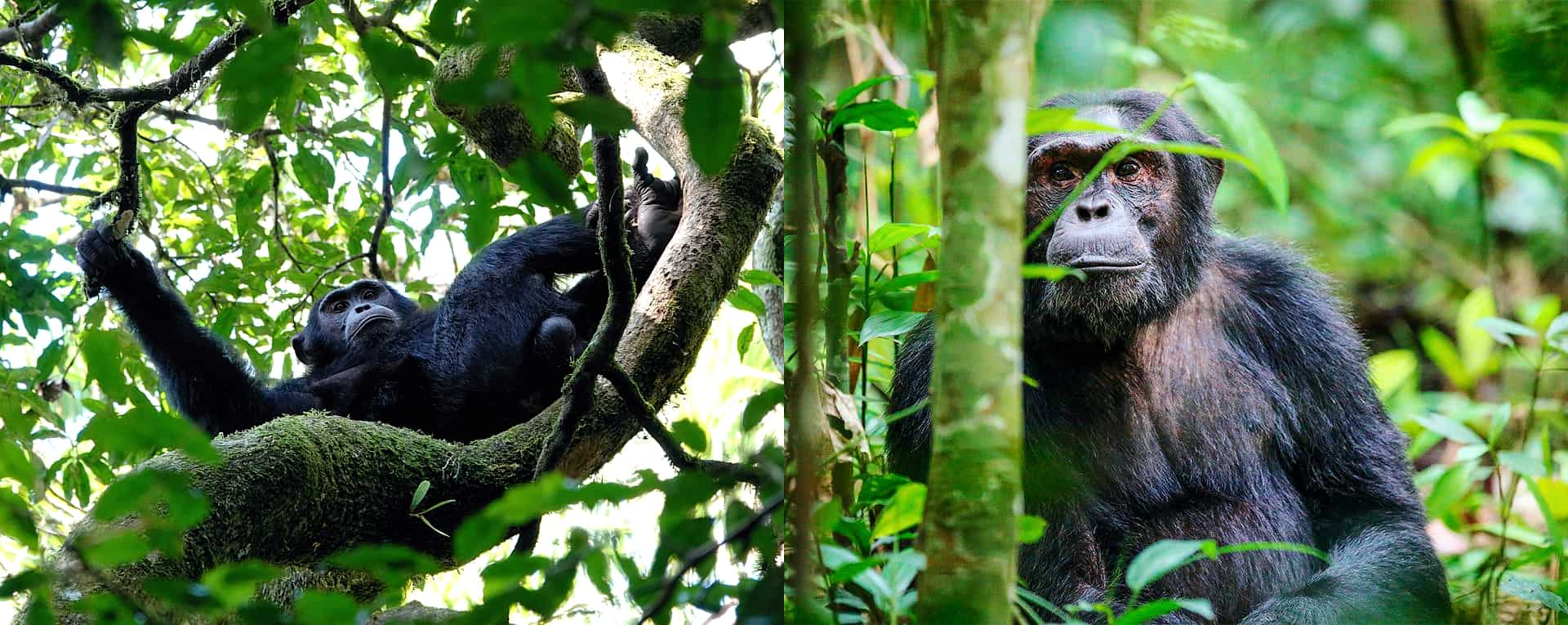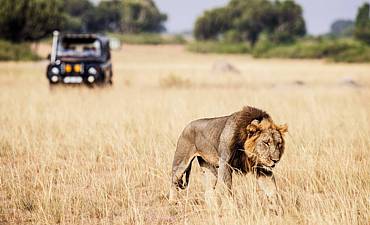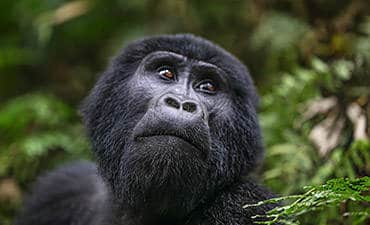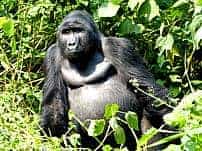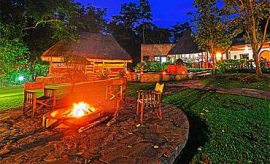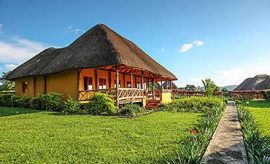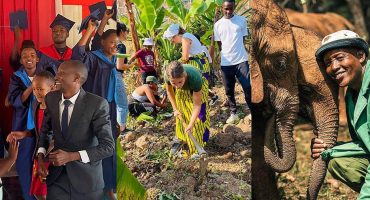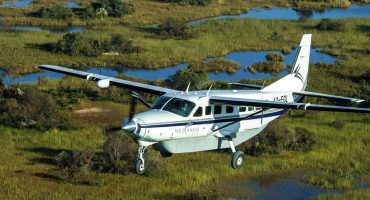CHIMPANZEE SAFARI TREKKING GUIDE ON KIBALE NATIONAL PARK IN UGANDA
Kibale Park Introduction - Location, Wildlife & History
Despite its relatively small size of 795 square kilometers, Kibale National Park is a stunningly beautiful natural reserve that captivates like-minded adventurers on their safari vacation in Uganda. The park received gazetted status as a protected area in 1932 and was formally declared a national reserve in 1993. Its most valued treasure is an incredible diversity of primates – 13 species in all, including the rare Eastern chimpanzee. Kibale stands on the northern boundary of the famous Queen Elizabeth National Park. Along with Semuliki National Park and Semliki-Tooro Reserve in the west, and Katonga Reserve on the east, the entire wilderness forms the Kibale Conservation Area.As you will discover on your safari vacation, Kibale Park is a 180-kilometer-long corridor that connects these major reserves and allows an unconfined passage of wildlife from distant Ishasha in the south of Queen Elizabeth Park all the way to the northern Sebitoli area. Aside from attracting the interest of tourists and wildlife enthusiasts, the park also forms an important center for study and research on primates. It’s the location of the famous Makerere University Biological Field Station. In addition, the Kibale Chimpanzee Project (KCP), founded in 1987 under the leadership of Dr. Richard Wrangham, is focused on studying the behavior, physiology, and favored habitats of the wild chimpanzees of Uganda.
An interesting facet of Kibale National Park (best time to visit) is that it covers a striking range of altitudes, from 1590 meters above sea level in the northernmost section to 1100 meters at the lowest point, where the southern section of the park slopes into the bed of the Albertine Rift Valley. This diversity of altitudes contributes to an amazing range of flora found within the park. Close to 77% of the park has a forest cover. This includes medium-altitude, moist-climate evergreen trees in the north. As you descend to lower altitudes during your travel through the park, you will come across semi-deciduous woodlands. In all, close to 351 species of trees abound here, and it’s not unusual to come upon specimens that are more than 200 years old and up to 55 meters tall.
The remaining 23% of the landscape on Kibale Park’s south side boasts wetlands, sprawling savannah grasslands where lions roam, and acreages of coniferous trees. This park is one of the last remaining regions with both mountainous rainforests and swamplands. The reserve has yet another notable feature: owing to its location in the Albertine Rift Valley, the landscape is dotted with extinct volcanic craters, some of which have transformed over the centuries into gloriously beautiful crater lakes that attract a variety of flora and fauna. The most famous of these lakes is the Ndali-Kasenda crater.
Kibale National Park is fast emerging as a favored destination on the Ugandan safari circuit thanks to the speedy development of an infrastructure that supports cultural tourism. This development is particularly notable because it involves several community projects and is focused on the participation of the local tribes, the Bakiga and Batoro. These people have survived in the forest for centuries, relying on its resources for food, fuel, raw materials for crafts, and medicines. By obtaining employment in the tourism industry, they can now earn a livelihood that was taken away with the setting of the reserve boundaries.
Key Takeaways
- Received gazetted status in 1932, formally declared a national park in 1993
- An incredible diversity of primates, home to 13 species in all, including the rare chimpanzees. 351 different species of trees and plants
- Adjoins the northern boundary of Queen Elizabeth National Park. Park is a 180-kilometer long corridor allowing the unrestricted passage of wildlife between the southern Ishasha sector in Queen Elizabeth Park to the northern Sebitoli region of Kibale Park
- Location of the renowned Makerere University Biological Field Station. Kibale Chimpanzee Project (KCP), established in 1987 under the leadership of Dr. Richard Wrangham operates in the park
- 77% of the reserve is covered with moist-climate evergreen trees and semi-deciduous woodlands. 23% of the reserve with wetlands, sprawling savanna grasslands, and mountainous rainforests. Landscape also having scenic craters left behind by extinct volcanoes now converted into lakes
Watch Video On Kibale Chimpanzee Safari Experiences
Travel Guide Content - Start Here
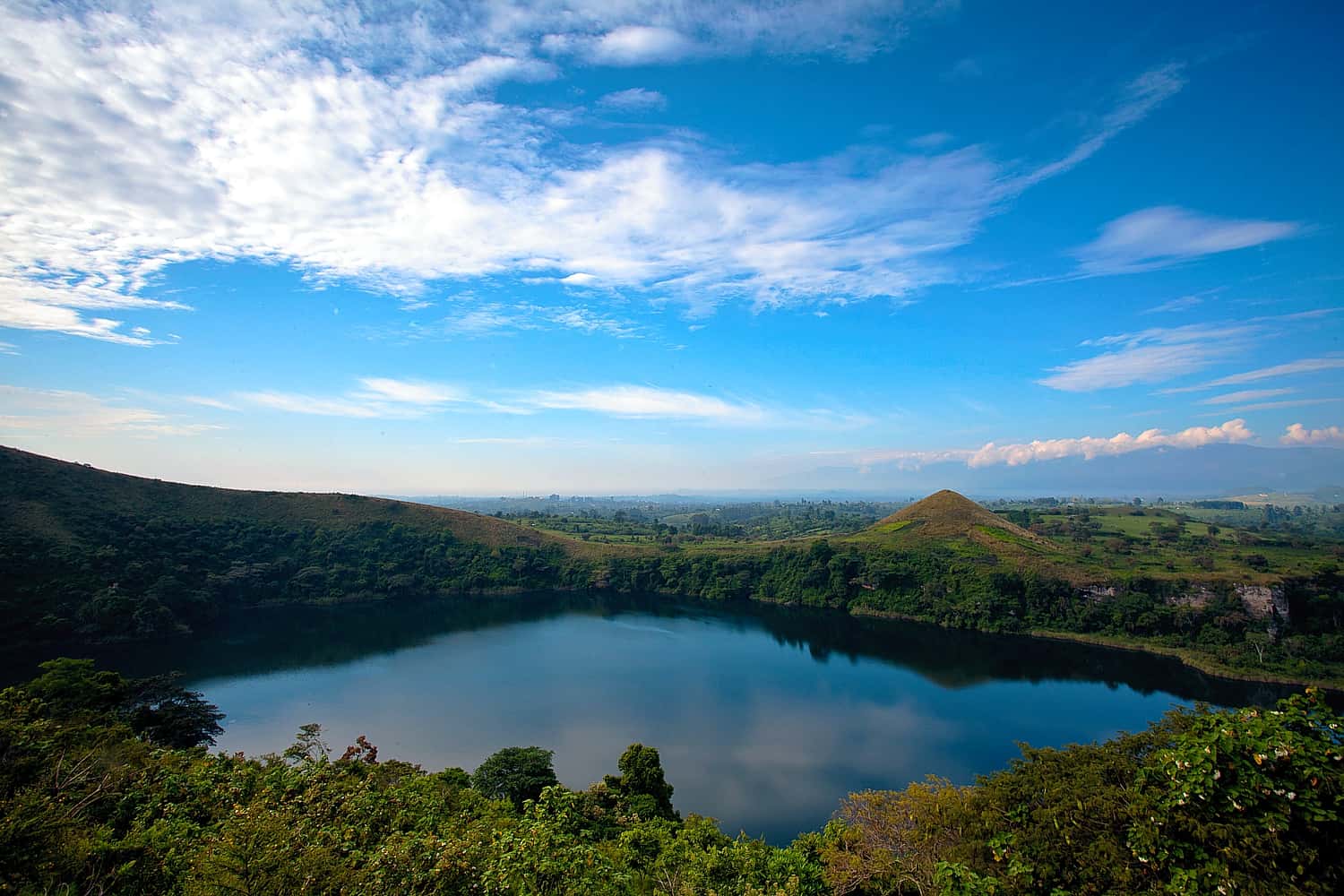 |
1. What Are The Wildlife Experiences In Kibale National Park?
Key Takeaways
- Close to 1500 individual chimpanzees known to live here, some of which have been habituated
- Park is also home to various other types of primates only found here
- Also has 70 species of mammals, 375 kinds of birds, 250 types of butterflies, and myriad reptiles and amphibians
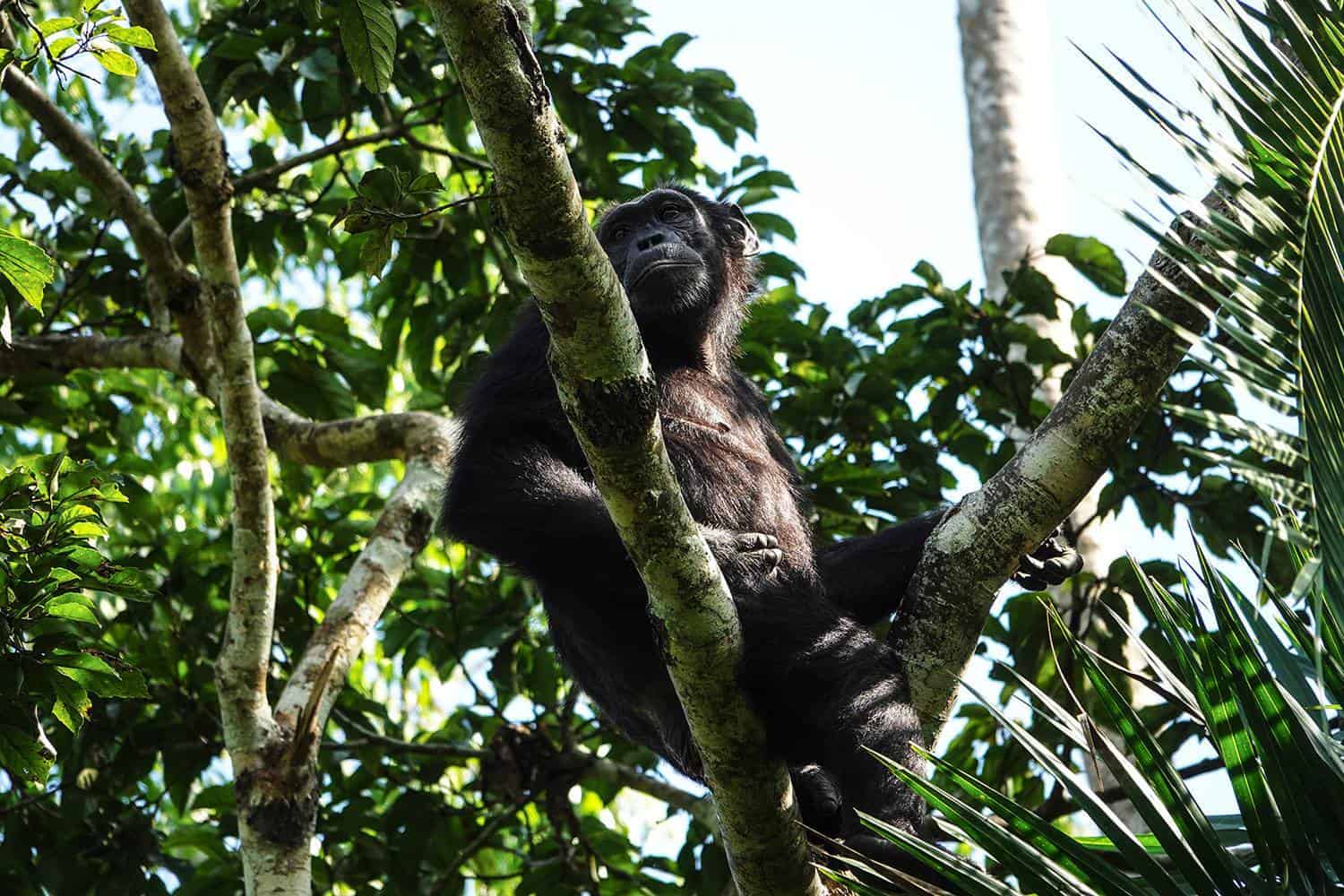 |
What Are The Areas Of Interest In Kibale National Park?
2. Chimpanzees & Primates Of Kanyawara, Ngogo, Kanyanchu & Sebitole Areas
Key Takeaways
- 13 species of primates, some of them exceedingly rare
- Main highlight is the opportunity to view the 1500 individual chimpanzees that thrive in the forests
- Research programs like the Kibale Chimpanzee Project (KCP) and Makerere University Biological Field Station working to study them
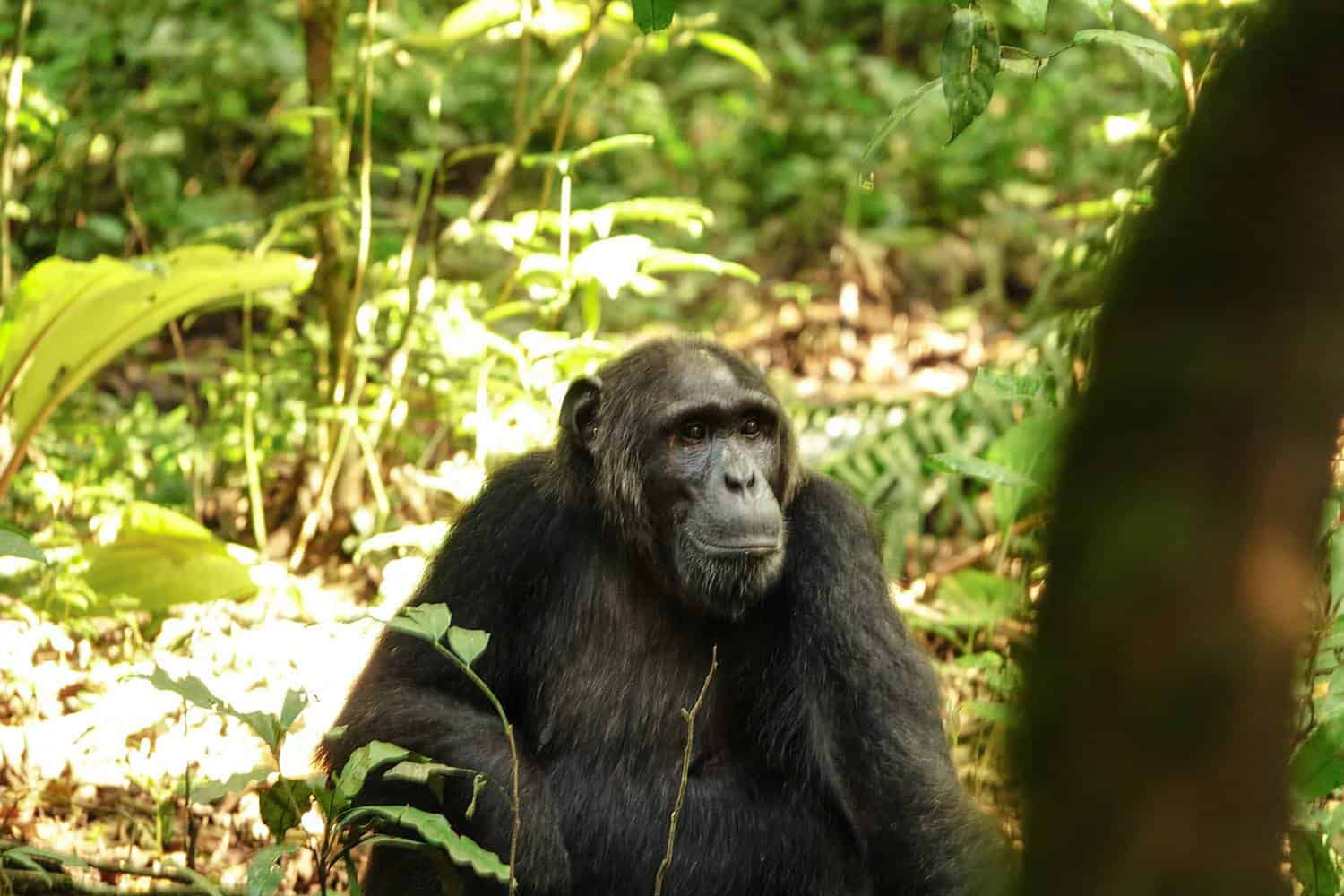 |
3. Viewing Other Wildlife In Kibale’s Conservation Areas & Uncharted Wilderness
Key Takeaways
- Possibility of sighting 375 avian and 70 terrestrial species of wildlife
- Close to 500 elephants and a range of herbivores and antelopes including the rare sitatunga
- Large and small predators, 250 kinds of butterflies, insects, reptiles, and amphibians
Among the predator group, lions, leopards, golden cats, serval, common genets, and the African palm civet are present primarily in the open south region of the park but rarely spotted. You could also see three kinds of mongoose: Alexander’s cusimanse, the marsh mongoose, and the banded mongoose. Check out the crater lakes of Kibale and you might run into swamp otters and hippos. In addition, your safari vacation in Africa will be made memorable by sighting some of the park’s 250 varieties of butterflies and myriad reptiles, insects, and amphibians.
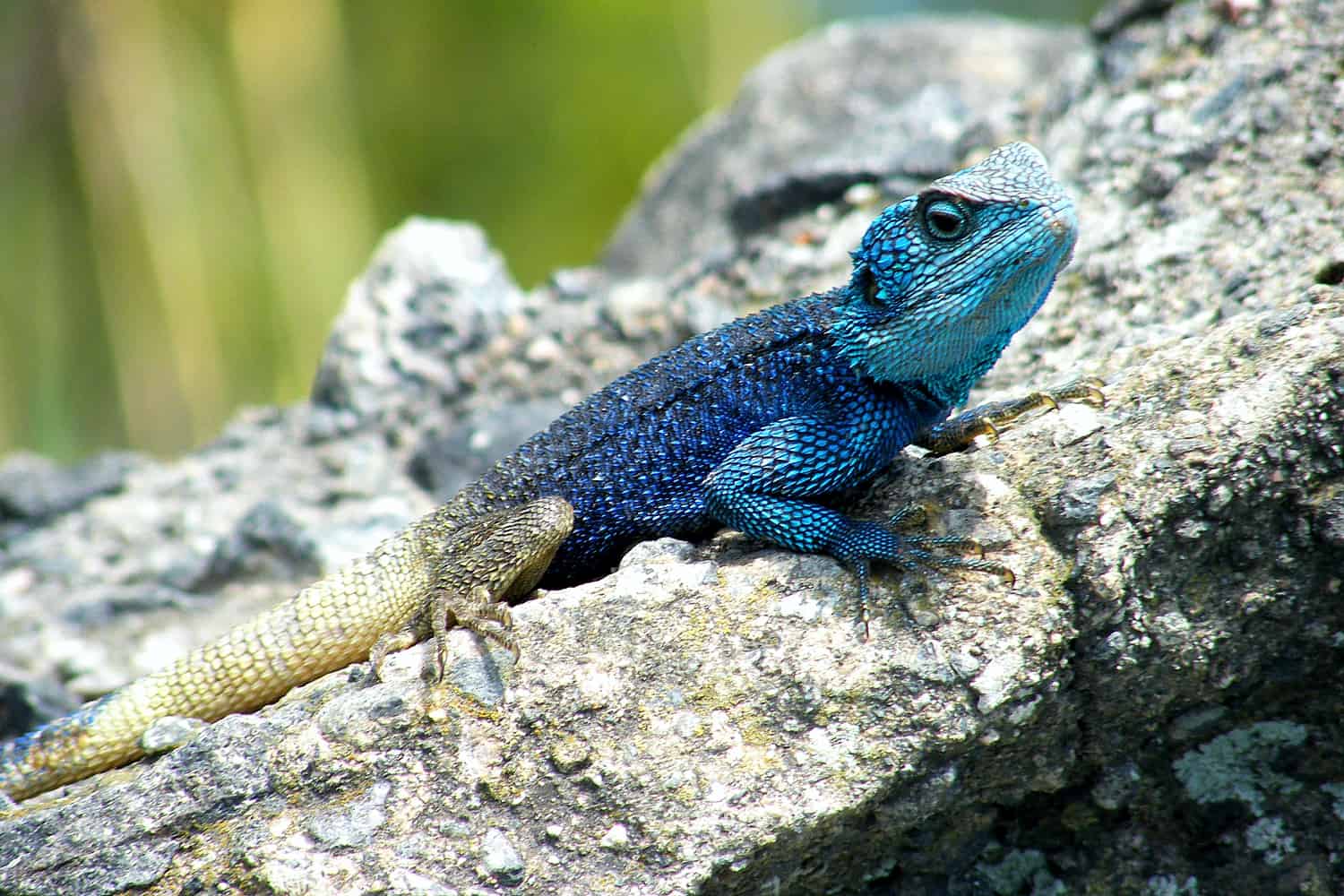 |
4. Bigodi Wetlands Sanctuary & The Kanyanchu Birding Area
Key Takeaways
- Birdwatching expeditions to spot some of the incredible avian life, of which 4 are only seen in Kibale
- 138 species of birds sighted in the Bigodi Wetlands Sanctuary
- Kanyanchu area also known for its incredible diversity of birds
As the AfricanMecca expert guide accompanying you will explain, Kibale National Park also hosts four species that are not found in any other location in Uganda. These include the blue-headed bee-eater, Cassin’s spinetail, masked apalis, and Nahan’s francolin. The Bigodi Wetlands Sanctuary alone boasts 138 types of avifauna. In this area you could spot the black-crowned waxbill, white-breasted negro finch, black bishop, Bocage’s bush-shrike, brown-crowned tchagra, superb sunbird, brown-throated wattle-eye, black-and-white shrike-flycatcher, brown-backed scrub-robin, white-tailed ant-thrush, grey-winged robin-chat, yellow-billed barbet, white-spotted flufftail, hairy-breasted barbet, and the yellow-spotted barbet.
The Kanyanchu area in Kibale National Park (where to stay) also has a high density of birds, and during your safari holiday you should keep your eyes peeled for the white-winged warbler, papyrus canary, papyrus gonolek, and white-collared oliveback. Other species that abound here include the fine-banded woodpecker, white-bellied crested flycatcher, red-faced crimson-wing, bar-tailed trogon, forest ground thrush, and the white-thighed hornbill.
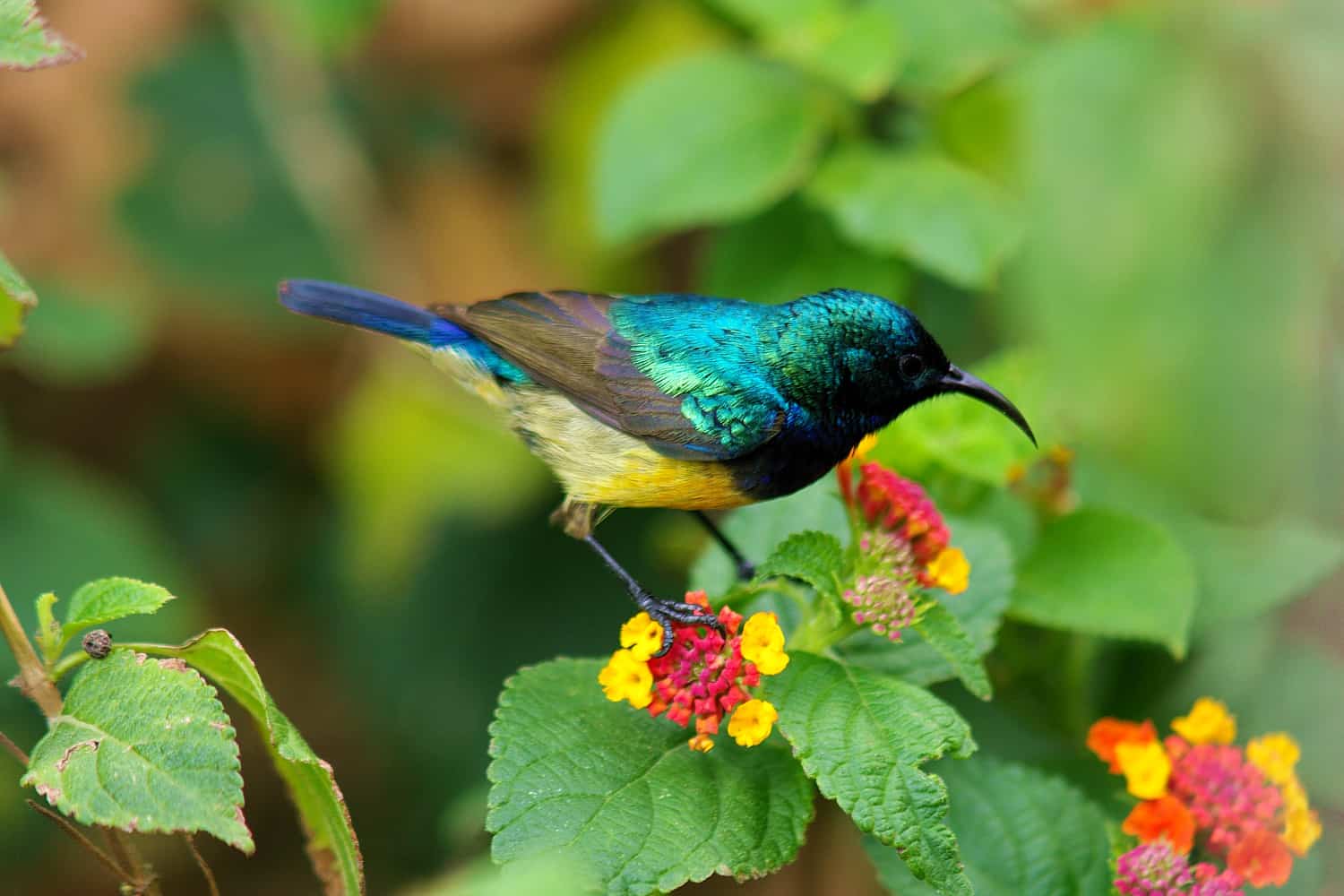 |
5. The Cultural Communities Of The Batoro & Bakiga Tribes
Key Takeaways
- Cultural heritage dating back to the ancient kingdoms thriving in the Great Lakes’ region
- Communities forced to relocate after the establishment of the reserve in 1993
- Upliftment of the Bakiga and Batoro people as a result of tourism
The Bakiga and Batoro have lived in the reserve for many centuries, relying on its resources for food, medicines, fuel, and raw material for making crafts and other essentials. After the mapping of the park boundaries in 1993, these tribes were forced to relocate to places outside the forests and adopt a way of living that is very different from their traditions. As a result, a large proportion of the people struggle for survival. In the past, they were often found trying to hunt in the park, which is both an illegal activity and endangers rare species of animals. Superb non-profit organizations such as The New Nature Foundation are now attempting to assimilate these people into the mainstream economy by offering training programs and providing opportunities for education and employment.
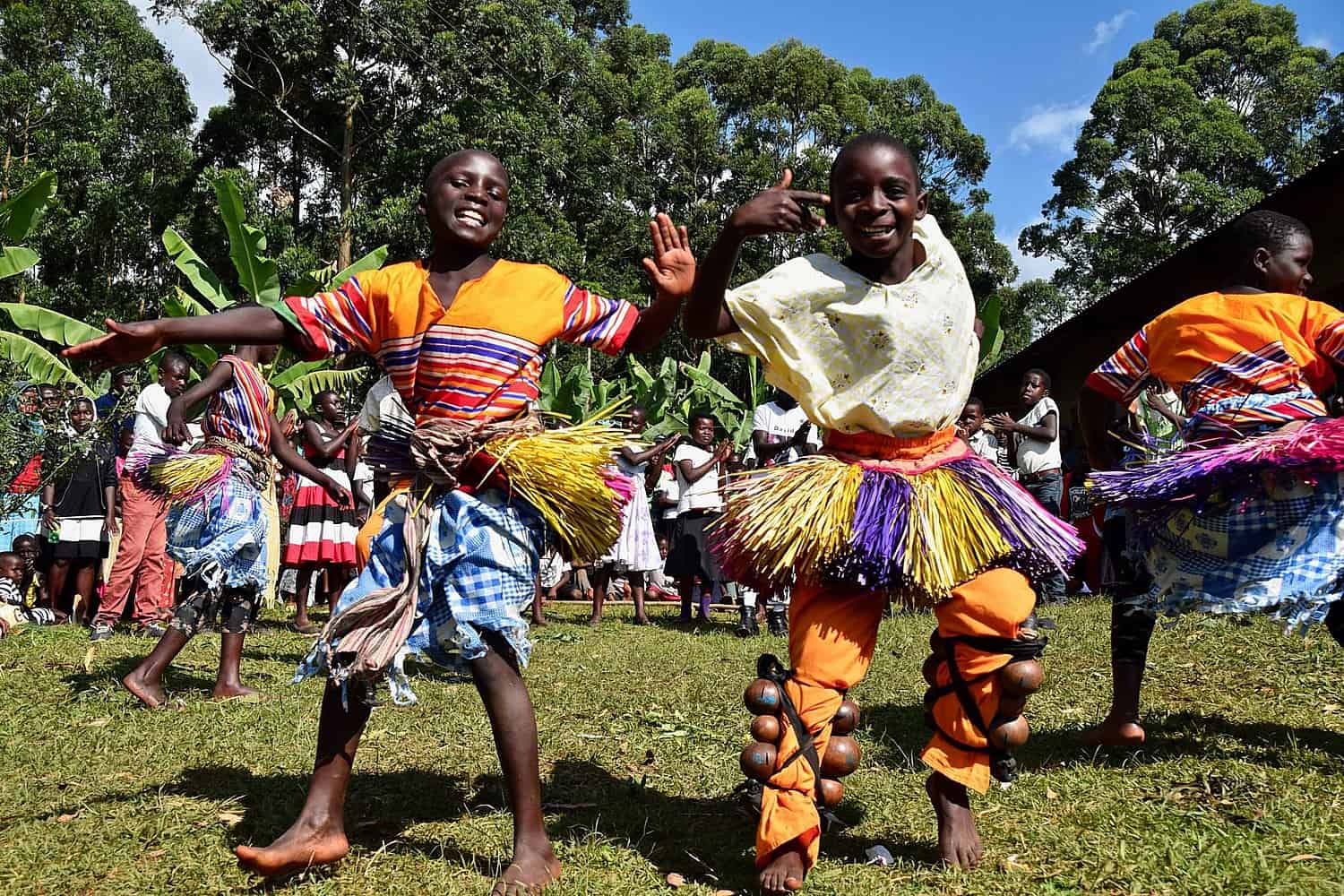 |
6. Viewing the Flora of Kibale
Key Takeaways
- Altitudes ranging from 1100 to 1590 meters above sea level with conditions ideal for the flourishing of diverse plant life
- Landscape showcasing tropical forests, moist evergreens, semi-deciduous trees, forests, savannah grasslands, conifers, and wetlands
- Combines forests on 77% of the land with grasslands and swamps on 23%
Further, the Kanyanchu region abounds with trees that reach for the skies at up to 55 meters, sheltering shrubs, ferns, and grasses that thrive in the dim sunlight filtering through to the forest floor. Closer to the Albertine Rift Valley floor are more of the grassy savannah fields. As you will observe on your trip, forests cover close to 77% of Kibale National Park. The remaining 23% consists of sprawling grasslands, wetlands, and conifers.
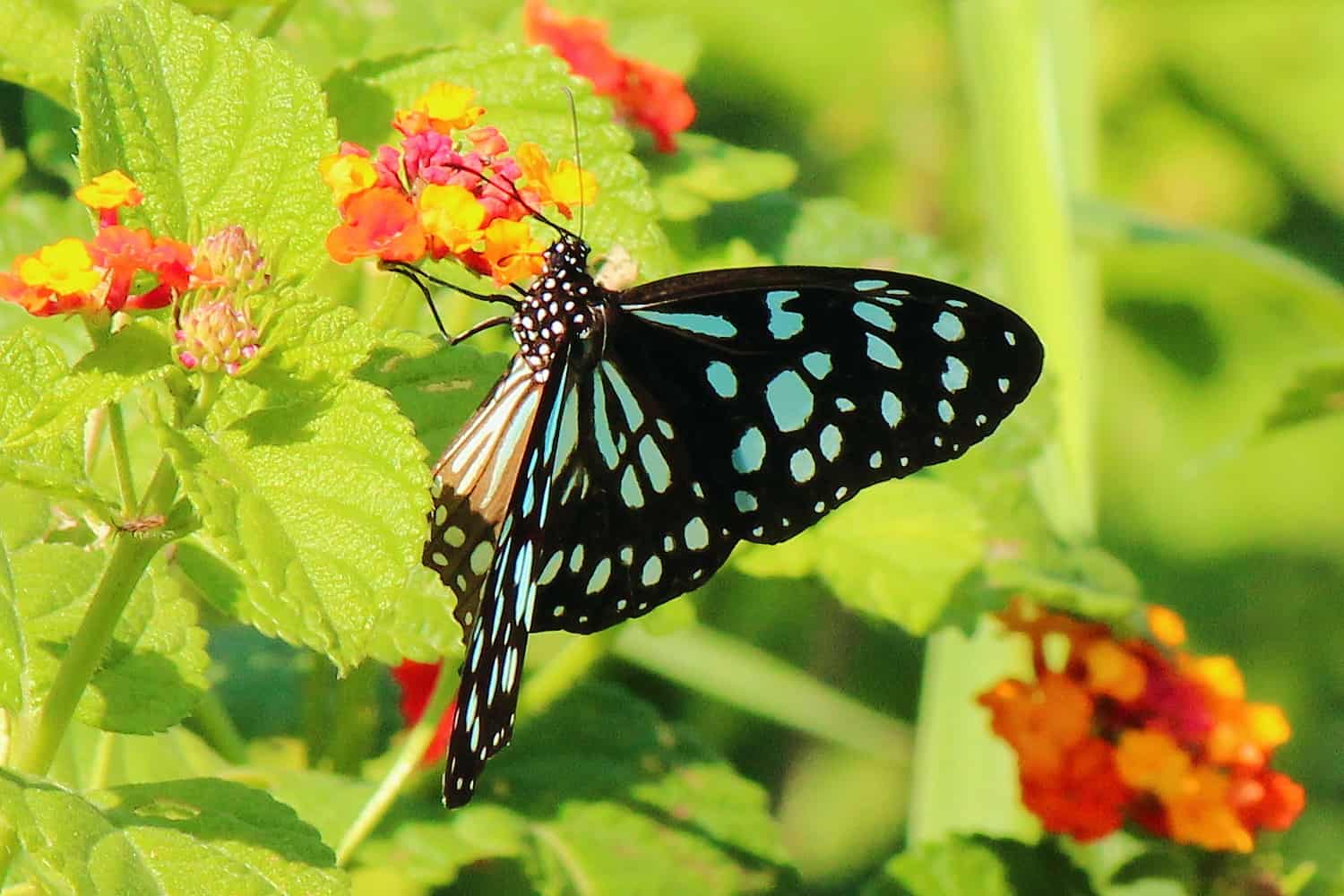 |
Select Our Highly Recommended & Unique Designed Uganda Safaris & Gorilla Treks That You Want To Tour Visit & Experience
What Safari Attractions & Tour Activities To Experience During Your Kibale Visit?
Key Takeaways
- Park landscape covering a range of altitudes that has a diversity of flora and incredible fauna living in them
- The primary activity is tracking wild chimpanzees. Kibale is home to an astounding 1500 chimpanzee individuals
- Each group allowed to spend 60 minutes with an assigned habituated family.
- Visitors allowed to accompany researchers as they observe and record primate activities and behavior
- Other activities including birdwatching, crater lakes hikes, cultural interactions, chimp habituation experience, canoe excursions, and night forest walks
The main attraction of the reserve is the astounding variety of primates found in this region of Uganda. During your primate trek tour in the park, you will learn that Kibale is famous for its population of nearly 1500 chimpanzees, along with 12 other types of primates including the grey-cheeked mangabey, black and white colobus monkey, spectacled demidoff, and bush babies. As you trek along the forest trails of Kibale National Park, also look for some of the 70 types of mammals, 375 bird species, 250 kinds of butterflies, and various reptiles, amphibians, and insects that make the park their home.
The expert guide accompanying you will have a keen knowledge of the forest and will help you spot the specific habituated family of chimpanzees that has been assigned to you. As per the regulations laid down by the Uganda Wildlife Authority, a fixed number of permits is issued to guests on their safari holiday each day, allowing them to spend a precious hour viewing the primates in their natural habitat.
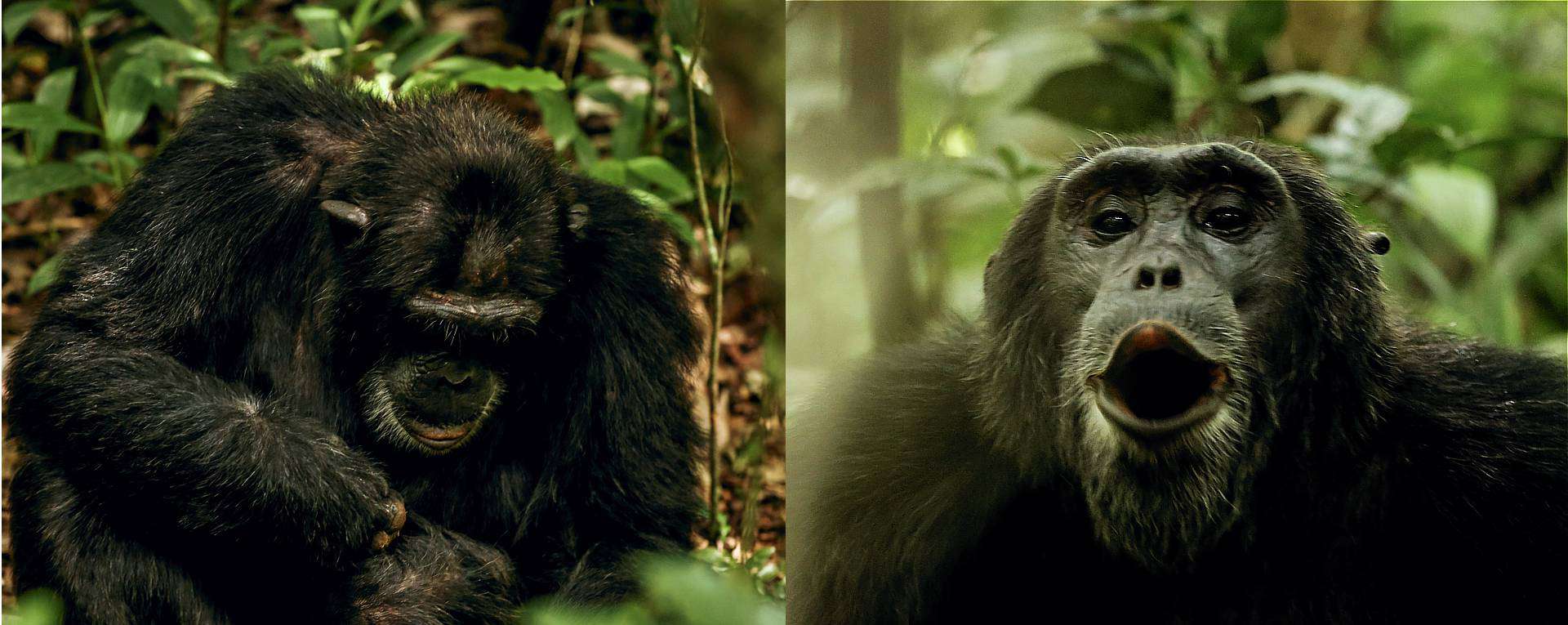 |
If you are an enthusiastic birder on safari in Africa, traveling to the Bigodi Wetlands Sanctuary is a must. This area abounds with a stunning diversity of birdlife which includes the rare shoebill stork. In addition to nature walks in the daytime, you can sign up for explorations in the late evening. Experience life in the bush as nocturnal creatures emerge from their hiding places to forage for food, even as other species settle in for the night.
Since Kibale Conservation Area lies in the Albertine Rift valley area, you can also enjoy seeing any of the several crater lakes that dot its landscapes, each a remnant of the intense volcanic activity that occurred here in the distant past. These lakes now act as magnets for avian fauna and are spectacular to view. You can also enjoy canoe trips on the lakes.
As enriching as it is to see the wildlife of Kibale National Park, so is experiencing the culture of this western region of Uganda. When safari vacationing in the reserve, take time to visit the outskirt villages of the Bakiga and Batoro tribes. Participate in their music and dances and, perhaps, take a lesson in making baskets, hats, and other handcrafted items. Learn about their ancient customs and tribal traditions and the fascinating art of making medicines from plants and herbs. Since young children under 12 years are not allowed on chimpanzee trekking safaris, you can sign them up for other activities such as batik painting, photographing nature, and fishing in the ponds.
Watch Video On Kibale Chimpanzee Trekking Experiences
Our Top 7 Safari Activities In Kibale - Things You Can Do & See
Activities Content - Start Here
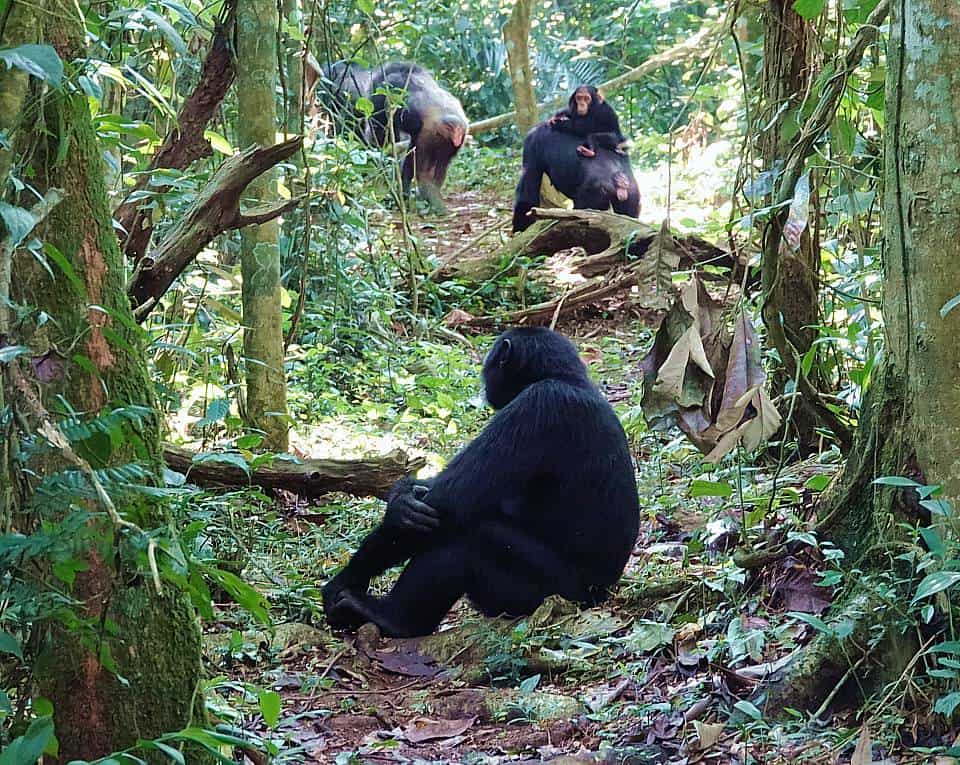 |
1. Chimpanzee Trekking Safaris In Kibale Forest
Key Takeaways
- Tracking down habituated families of chimpanzees that live in the park; orientation sessions provided to instruct visitors on what to expect
- Chimpanzee trekking safaris beginning at 8 a.m. or 2 p.m. Each trek taking around 2 to 3 hours walking along easy to moderate hiking trails
- Only 24 permits issued each day for 3 groups with a maximum of 6 to 8 members. There are also 2 addiitional groups available
Before starting out, you will attend a short orientation session where you will learn about the do’s and don’ts of your visit, and other rules to follow when in the company of the chimpanzees. Each trip takes 2 to 3 hours of walking along easy to moderate forest trails — more like a nature walk than a high intensity hike. The experienced tracker leading the way will locate the family so you can reach them in less time. Once you find the family, you will be allowed to spend 60 minutes in their company, observing the chimps as they forage for food, hunt, groom one another, mating, nap in the trees, or even descend to the ground for introspect.
Each group of visitors consists of 6 to 8 members. To join a group, you must obtain a permit prior to arrival from the park authorities. And since only 24 permits are issued each day in Kibale National Park, be sure to inform your AfricanMecca Safaris consultant of your wish to go chimpanzee trekking at the time of booking your adventure safari holiday in Uganda
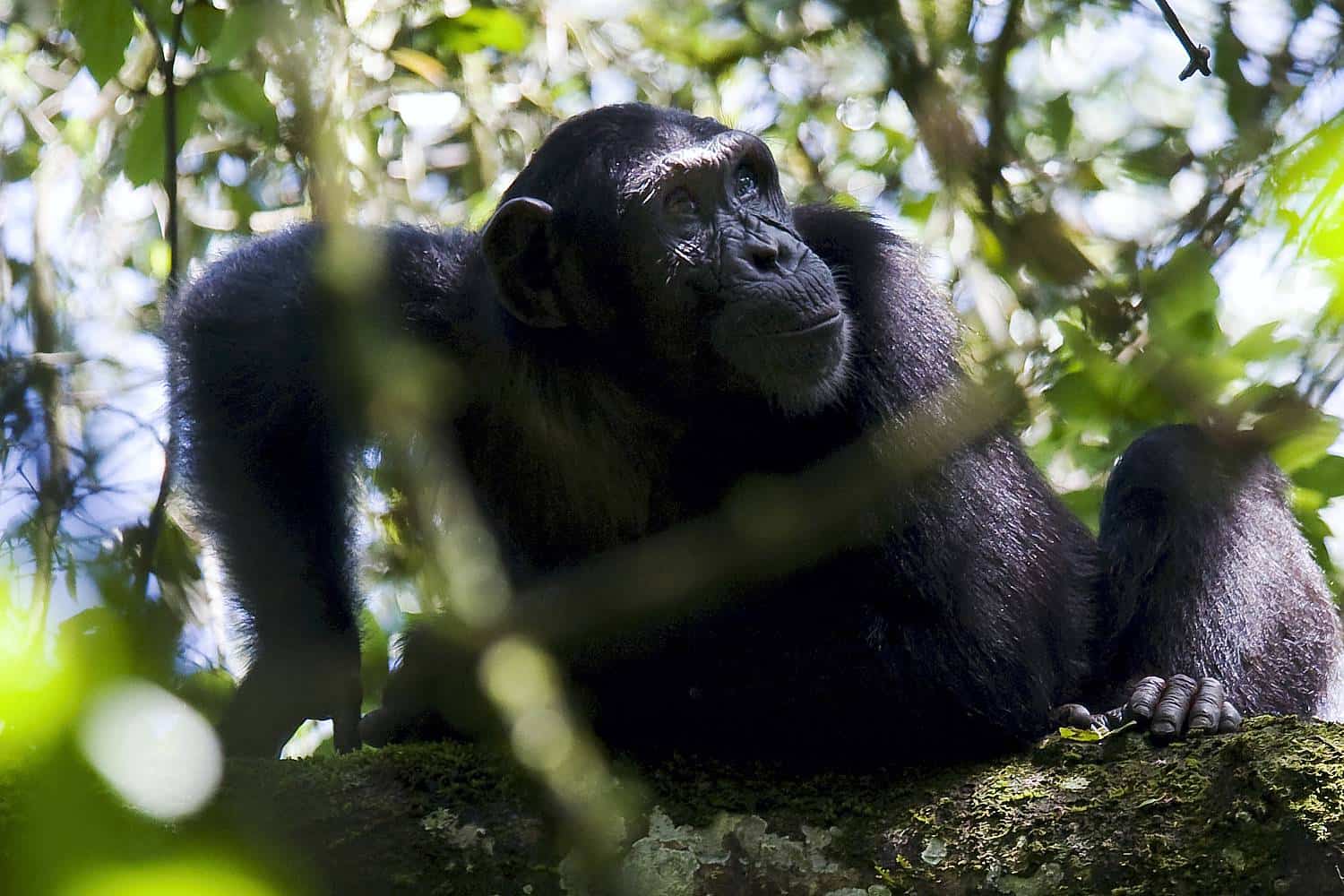 |
2. Kibale Chimpanzee Habituation Experience (CHEX) Safari
Key Takeaways
- Participating in the Chimpanzee Habituation Experience (CHEX) where research rangers study the primates and familiarize them with the presence of humans.
- Each excursion starts at 6 a.m. and lasts up to 7 p.m. Only 6 visitors allowed to join the CHEX trek on a given day, so acquiring permits months prior to arrival is highly recommended due to high demand
- Opportunity to study chimps as they forage for food and caring for their young
Once spotted, you can watch them foraging for food, mating, nursing their young, or patrolling the perimeters of their territory in Kibale National Park. On rare occasions, travelers have had the good fortune to see them at closer range as they are not fully habituated, when they descend to the forest floor. Your excursion will end with a return back to the park base by 7 p.m. This is to ensure chimps get their privacy when they build new nests in the trees and settle in for the night. Only 6 guests are allowed to participate in the habituation experience each day.
You’ll want to keep in mind that, as a rule, chimpanzees are shy creatures and will take off if they see humans approaching. However, CHEX allows for a more intimate view of how scientists study the families in an unobtrusive, non-threatening way, so that the chimps accept human visitors as part of the environment of Kibale National Park. You will be delighted to see how the animals continue with their activities, scarcely paying any attention to you. Most Kibale accommodations provide a packed lunch for you to bring along for the day, and you can spend your time asking the researchers questions and observing every aspect of the primates behavior, which is often amazingly similar to humans.
Since only a fixed number of permits are issued each day for CHEX, it’s best to discuss your plans with the AfricanMecca tour operator well in advance. Please note that CHEX experience is high intensity, and requires trekking for many hours of following the chimpanzees over long distances. There is always a rare possibility of not finding the semi-habituated chimps for the day, and you may then be redirected to observe the habituated chimpanzees of the Kanyanchu group.
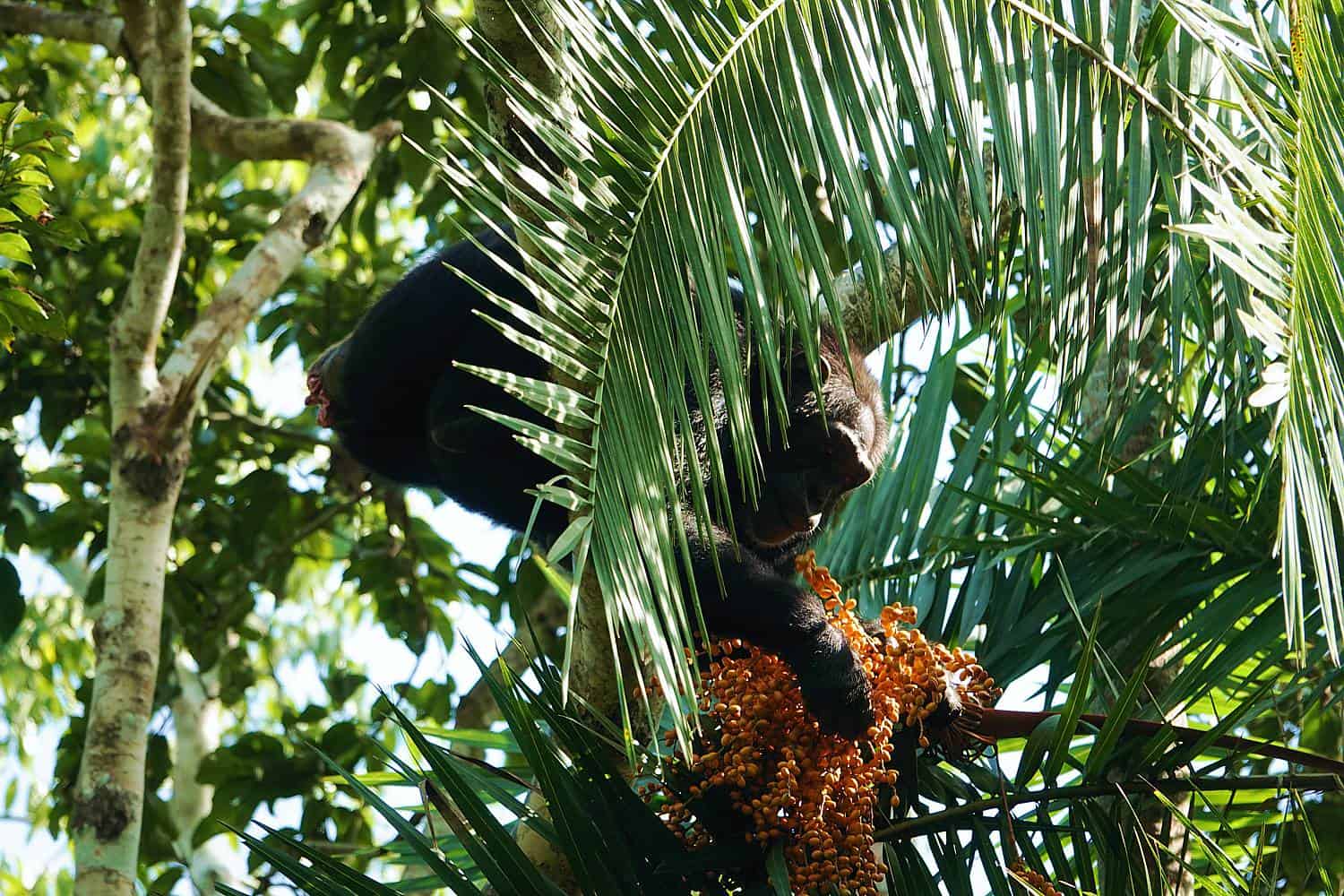 |
3. Birdwatching Safaris In Kibale
Key Takeaways
- Birdwatching excursions around some of the prime locations in the reserve. Possible sightings of various species during chimpanzee-trekking safari in the Kanyanchu locale
- Knowledgeable guides to accompany visitors and talk about bird habitats, breeding, feeding and nesting habits
- Opportunity to view breeding and migratory birds
The expert Uganda birding guide accompanying you will help you spot the various species and explain in detail their favored habitats and nesting habits. There are several viewing platforms and boardwalks in the forest that make spotting birds a lot easier. Should you choose to visit Kibale National Park (best time) from March to May and September to November, you may come across various breeding birds in their plumage with plenty of food available. Migratory birds arrive south around November to April to escape the cold winters of the northern hemisphere, and are best seen in the open areas rather than woodland areas of Kibale.
As you travel along the forest trails, look for species such as the superb sunbird, yellow-billed barbet, black-and-white shrike-flycatcher, white-spotted flufftail, hairy-breasted barbet, black bishop, Grey-winged Robin-chat, brown-throated wattle-eye, black-crowned waxbill, papyrus gonolek, white-tailed ant-thrush and many more.
Below is a list of some of the birds of Kibale National Park
|
|
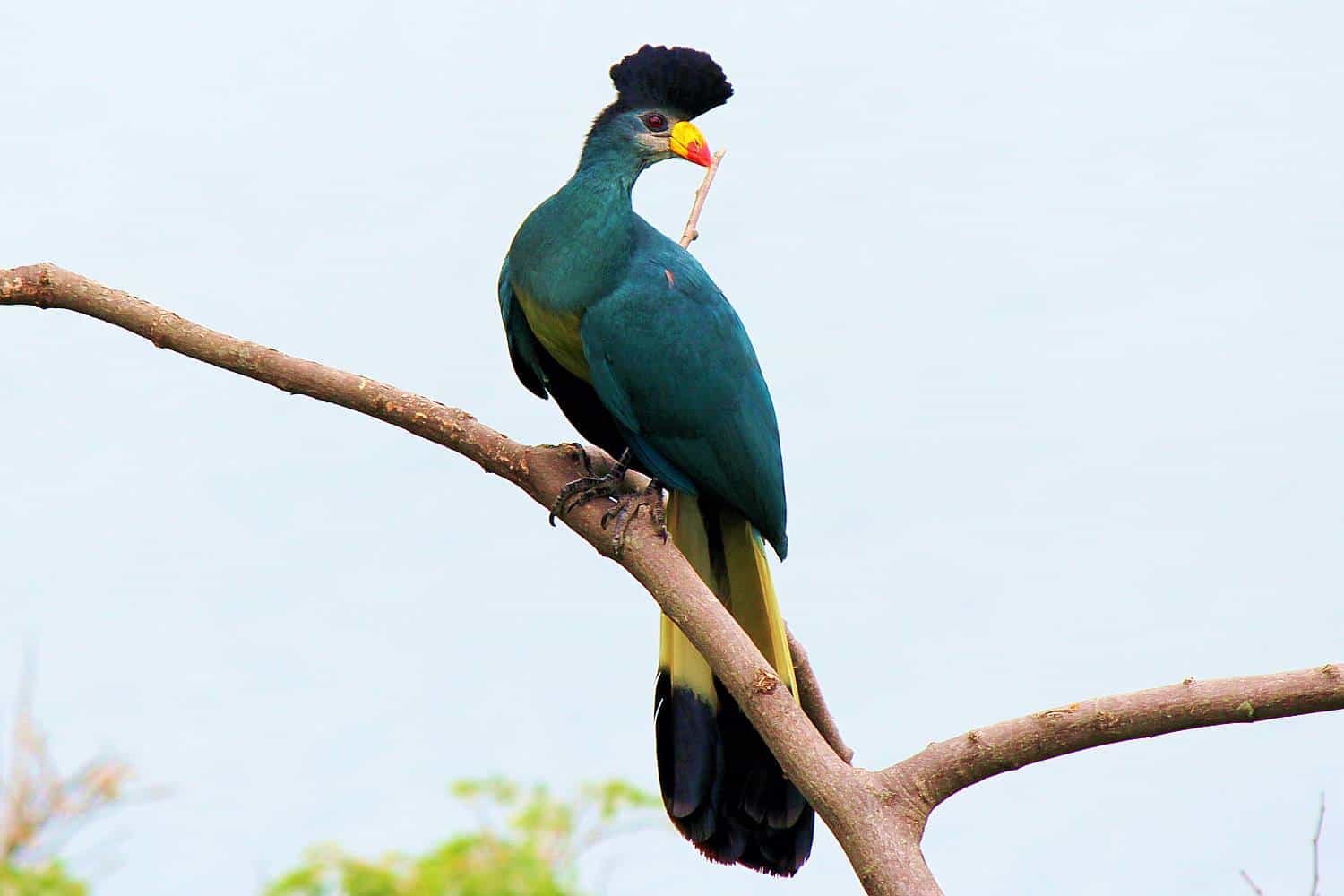 |
4. Exploring Spectacular Crater Lakes Of Kibale & Top Of The World
Key Takeaways
- Exploring the crater lakes of the Albertine Rift Valley left behind by centuries-old extinct volcanoes
- Hiking trips to the rims of the lakes including “Top of the World” for fabulous views of the surrounding landscape and viewing birds and small animals. Touring various other lakes for fishing and canoeing
- Excursions starting in the early morning and lasting for three hours, visitors advised bringing a packed lunch
The most famous lake in the west of Kibale National Park is Lake Nyinambuga, which has been featured on the Uganda 20,000 currency note. Lake Nkuruba has perhaps the most picturesque vistas and is known by visitors as a great place to spot red colobus and black and white colobus monkeys. While canoeing and fishing are interesting activities to do at the lakes, swimming isn’t encouraged here because of hazards such as bilharzia. You’ll also want to avoid encroaching on the local hippos’ territory in Lake Nyabikere, also known as the Lake of Frogs. Other craters you could consider exploring are Lake Nyinabulitwa, Lake Nkuruba, and Lake Nyamirima. For a walk through the famous Arabica coffee plantations, you can travel to Lake Kasenda.
Most crater hikes in Kibale begin early in the morning, so you can scale the slopes while the weather remains relatively cool. On your hiking tour of the “Top of the World” excursion, we recommend that you bring along a packed lunch, along with adequate bottled water or other beverages to remain hydrated. Wear tough hiking boots and clothing that covers you completely. Also, bring a light rain jacket and a walking stick to help you scale the slopes. A typical crater lake excursion takes about three hours to complete, and the AfricanMecca assigned guide accompanying you will regale you with tales of the exciting history of Kibale’s crater lakes as you enjoy sighting many species of the local flora and fauna.
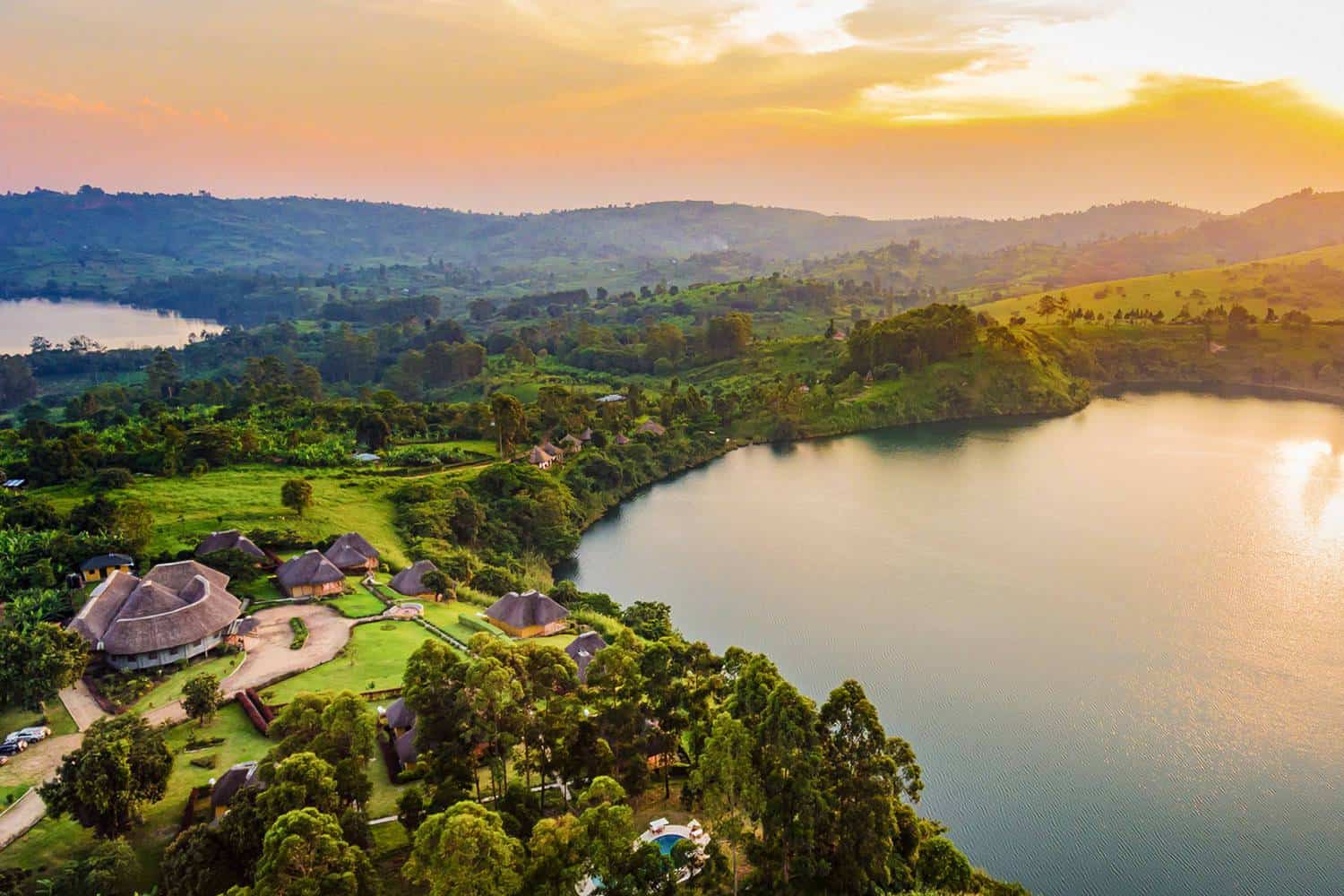 |
5. Kibale Evening Forest Walks
Key Takeaways
- Night walking excursions to spot nocturnal creatures that become active at night. Unique experiences of the forest including the sights and smells of the twilight zone
- Forest walks starting at 7:30 p.m. from the park headquarters after dinner
- Each trek lasting for 1.5 to 2 hours is conducted in the company of an expert forest guide
A typical night forest walk begins at 7:30 p.m., right after dinner, from the park headquarters, where you will receive a short orientation talk given by the Uganda Wildlife Authority rangers. The trek continues for 1.5 - 2 hours, and you will be carrying high-powered torches (flashlights) to hike tour the forest trails in the company of an expert guide. It is advisable to bring at least a liter of water in your backpack and come dressed in long pants with the hems or gaiters tucked into the tops of sturdy boots. You may want to wear a long-sleeved shirt and insect repellent to prevent bites. Having a lightweight rain jacket along in case of a sudden shower is also recommended.
The consultants at AfricanMecca Safaris recommend this adventure vacation activity (reasons to visit Uganda) because experiencing the African jungle at night has a whole different feel. It is not for the faint hearted! You’ll hear the chirping of crickets and the high-pitched shriek of a hyrax, mingled with the chatter of chimps. Breathe in the scents of the forest at night and catch sight of a reptile in a tree. All of these sensations envelop you and provide a glimpse of a unique facet of Kibale National Park – one that remains hidden in the daylight.
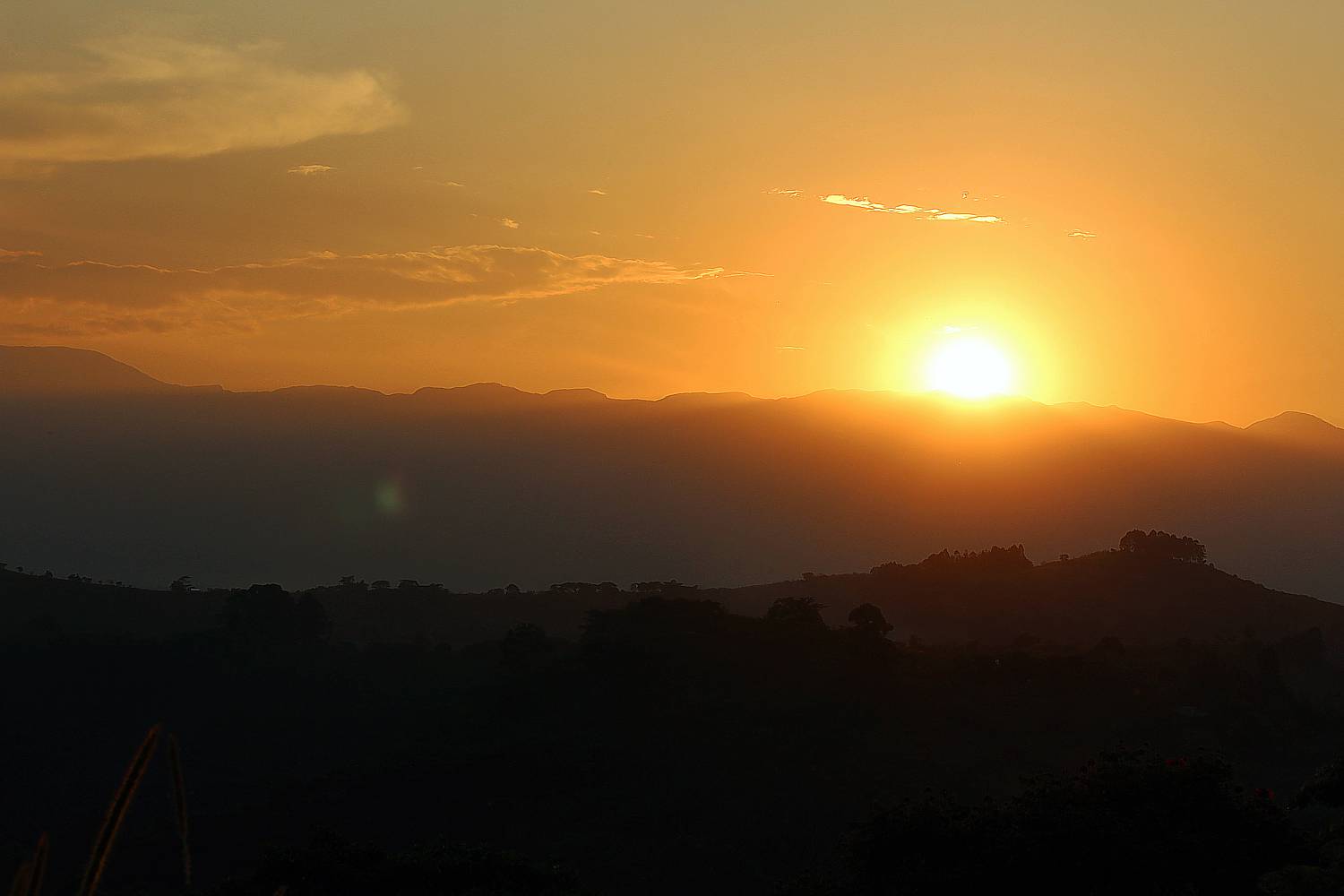 |
6. Cultural & Community Tours Near Kibale Park
Key Takeaways
- Kibale Association for Rural and Environmental Development (KAFRED) organized to conserve the culture and livelihood of communities displaced by the park’s official demarcation. Winner of the esteemed UNDP Equator Initiative Award assisting people with education, health, and sanitation
- Visitors welcomed to interact with the Bakiga and Batoro communities to learn about their traditional way of life.
- Visits to the village church, school, and village medicine man. Engaging in the folklore of the people who relate tales of their history and travels to their present-day home
Book a cultural tour on your Uganda safari where you can visit the local village to develop an understanding and appreciation of the lifestyle of the Batoro people. Your excursion will include a visit to the village church, elementary school, and the village medicine man. Learn about the activities traditionally undertaken by women, as well as their rites and ceremonies. You will also hear tales such as “The Village of Two Tribes,” which talk about the travels of the migrating Bakiga clan and their assimilation with the native Batoro in the 1950s. Members of KAFRED may also take you on a nature walk through the Magombe swamplands of Kibale’s conservation wilderness to view the resident fauna.
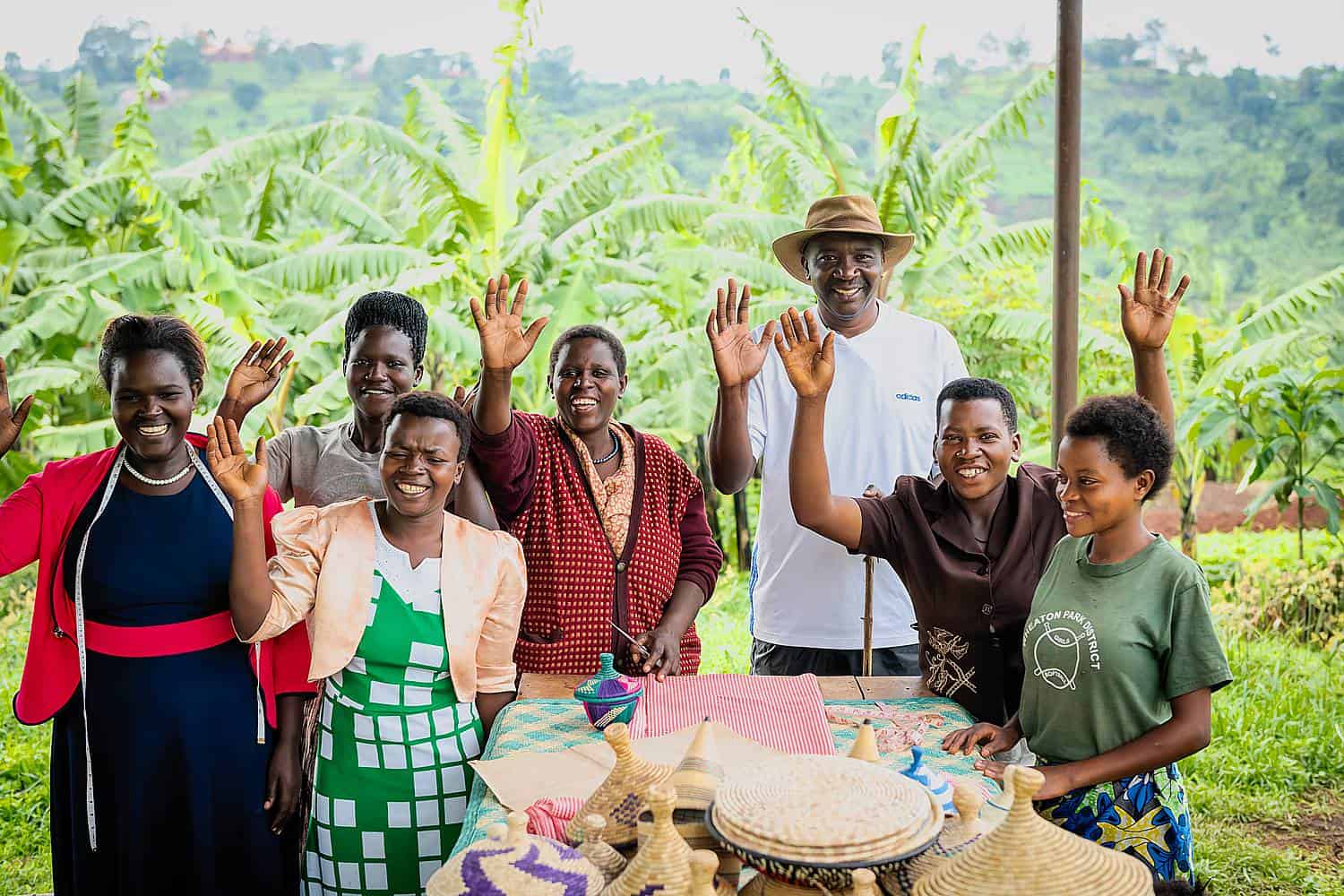 |
7. Touring Bigodi Wetlands Sanctuary For Primates & Birds
Key Takeaways
- Visits to the Bigodi Wetlands Sanctuary located in the Magombe Swamp
- Sightings of 8 species of primates and 138 species of gorgeous birdlife
- Earnings from tourism used for the upliftment of the community and building of infrastructure.
The Bigodi Wetlands Sanctuary takes its name from the Rutooro word kugody, which means “to walk wearily,” and is managed by the local Kibale Association For Rural And Environmental Development (KAFRED). The local communities linked to KAFRED benefit from tourism activity in Kibale National Park, and the earnings from safari guests go toward the building of roads, schools, bridges, and to pay the wages of teachers. The farmers also earn an income from selling their produce to the lodges and camps set up around reserve, and from receiving visitors in their African-style homes to introduce them to the typical Batoro lifestyle.
Various other occupations have also emerged among the local communities, mainly centering on visitor presence in the region. Since they’re experts on the flora and fauna of Kibale, many of the tribe’s members now work as guides, an employment activity that has led to the cessation of poaching within the boundaries of the park and sanctuary. Tourism now supports the higher education of the children of the villages. Meanwhile, the 40-member Bigodi Women Group creates handicrafts using sustainable raw materials from the wetlands. These goods are sold locally and exported to various global locations.
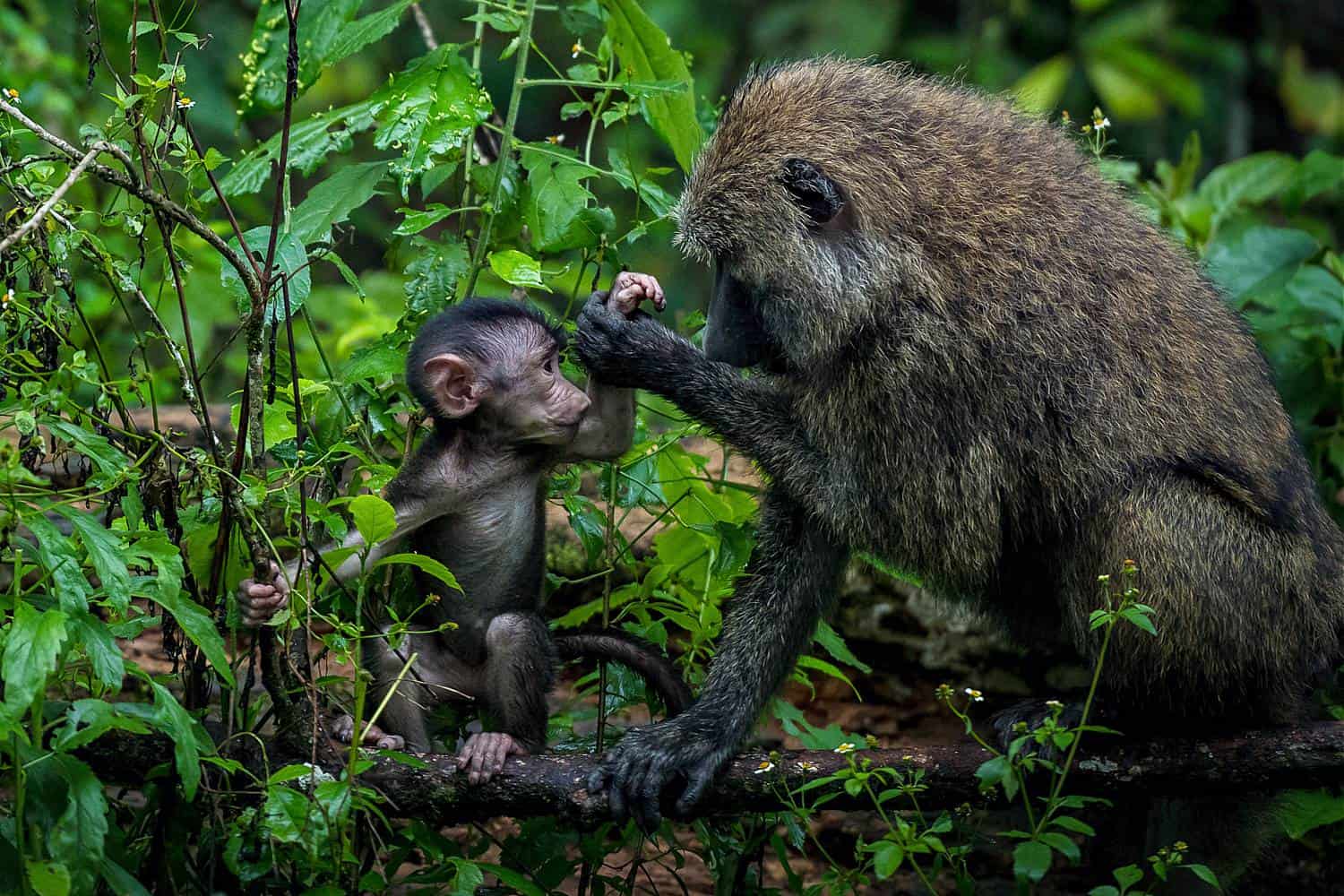 |
Select Our Highly Recommended & Unique Designed Uganda Safaris & Gorilla Treks That You Want To Tour Visit & Experience
|
Kibale Park Rating By AfricanMecca
4
Star
Wildlife Exclusivity Activities Accommodations Authenticity
Users
(0 votes)
0
|
Learn More On AfricanMecca Safari Tier Ratings & Experiences |
Write A Trip Review On Kibale In Uganda
Read More +
WHERE & BEST PLACES TO STAY IN KIBALE
Kibale has varied accommodations, from the luxuries of Kyaninga Lodge to the deluxe option of Ndali Lodge. The value lodge options in Kibale National Park are Crater Safari Lodge and Primate Lodge.
Read More +
KIBALE SAFARI ACTIVITIES & TOUR ATTRACTIONS
Experience chimpanzee trekking safaris in Kibale. Other activities including birdwatching, crater lakes hikes, cultural interactions, night forest walks, chimp habituation experience, and canoe excursions.
Read More +
BEST TIME TO VISIT KIBALE
Like most locations in Africa, Kibale National Park has two wet rainy seasons and two dry seasons. June to August and end of December, January, and February is the best time to visit Kibale in Uganda.
AFRICANMECCA REVIEWS
What are our Customers saying about us? READ MORE REVIEWS
AfricanMecca Safaris offers incredibly knowledgeable and skilled services! Our travel arrangements for 2 months of volunteering with TEACH Rwanda in country were made quickly and economically. Honored to work with Raza!
Janet Brown - TEACH Rwanda Founder - United States
I just returned from a month in Africa, specifically Rwanda & Kenya. I am left breathless with my experience. AfricanMecca Safaris coordinated the entire trip for me and left no detail, nothing for me to do.
Carol Bobb - Pennsylvania, United States
AfricanMecca Safaris created a remarkable honeymoon tailored to our interests and desires. The quality of service and delivery of experience was unsurpassed. I highly recommend AfricanMecca Safaris to honeymooners, families, or any traveler.
Noorin & Jason Nelson - Maryland, United States
I booked my safari holiday through AfricanMecca. They were the most helpful company I have ever dealt with and I work within the travel industry. I had the most amazing time. The holiday went as clockwork with no hitches anywhere.
Shelley Roberts - Hemel Hempstead, United Kingdom
This is to let you know my guests, The Bryant's, had a wonderful time on the trip Samburu, Masai Mara/Kenya, Chobe/Botswana & Victoria Falls/Zambia. Everything was perfect! Thank you.
Christine Milan - MT Carmel Travel - Connecticut, United States
We have returned from our African adventure and would like to thank you very much for your part in making this such a wonderful experience. We were lucky enough to time the Great Migration from the Serengeti, which was amazing.
Denise Paterson - Belmont, Australia
Rwanda was amazing. The accommodations, food, and guides AfricanMecca arranged were great. Raza also helped us through the complicated process of getting permits for gorilla trekking. AfricanMecca is a fantastic company to work with.
Stephanie Weir - United States
EAST AFRICA SAFARI BOOKING TRIP IDEA FOR KIBALE IN UGANDA
When visiting Kibale for your chimpanzee safari tour, we recommend combining it with Bwindi Park for your gorilla safari trek, Queen Elizabeth and Murchison Falls for your wildlife safari, and alongside your city tour visits of Kampala and Entebbe.
You may optionally extend out to other wilderness areas such as Mgahinga to track down golden monkeys and gorillas in the same park, Jinja for whitewater rafting on the Nile River, and Semliki, Lake Mburo or Kidepo for an offbeat wildlife tour.
You can end your vacation on the beach at Lake Victoria or even extending out to the exotic spice island of Zanzibar or Lamu, or even Mombasa.
Best Safari Planning Ideas & Trip Experiences For Uganda
Below are guide references on how to plan each of the below safari experience in Uganda. Alternatively, go to the summary section for a quick overview of each trip planning experience.1. How To Plan Uganda Safari Trips? (Summary)
2. Wildlife Safari Trip Planning Guide For Uganda
3. Private & Tailor-Made Safaris Trip Planning Guide For Uganda
4. Honeymoon Safaris Trip Planning Guide For Uganda
5. Family Safaris Trip Planning Guide For Uganda
6. Luxury Safaris Trip Planning Guide For Uganda
7. Photo Safaris Trip Planning Guide For Uganda
8. Cultural Safaris Trip Planning Guide For Uganda
9. Gorilla, Chimpanzee & Primate Safaris Trip Planning Guide For Uganda
10. Hike, Trek & Bush Walk Safaris Trip Planning Guide For Uganda
11. Birding Safaris Trip Planning Guide For Uganda
12. Wedding Safaris Trip Planning Guide For Uganda
READ MOREKickstart Your Safari Planning
ARE YOU PLANNING TO BOOK AN AFRICAN SAFARI TO KIBALE IN UGANDA?
Do You Need Knowledgeable, Experienced & Specialist Guidance For Your Travels In Kibale ? Let Us Help Plan Your Trip Itinerary Correctly
CONTACT AN AFRICA TRAVEL EXPERT ON KIBALE NATIONAL PARKEXPLORE MORE ON KIBALE NATIONAL PARK IN UGANDA
HAVE YOU VISITED KIBALE FOR AN AFRICA SAFARI IN UGANDA?
Write A Travel Or Tourist Trip Review To Share Your Experiences
WRITE KIBALE REVIEWAMS BLOG
VIEW ALL -- 24 December 2024 by AfricanMecca Safaris, in Blog For AfricanMecca Safaris,Safari Planning Blog Posts - AfricanMecca Safaris
What AfricanMecca Accomplished In 2024
What AfricanMecca Accomplished In 2024 Published By AfricanMecca Safaris | Blog ...READ MORE + - 26 October 2017 by AfricanMecca Safaris, in Blog For AfricanMecca Safaris,Safari Planning Blog Posts - AfricanMecca Safaris
Baggage Guidance, Flight Shuttle Service & Restrictions On Flying Safaris In Africa
Baggage Guidance, Flight Shuttle Service & Restrictions On Flying Safaris In...READ MORE + - 07 June 2017 by AfricanMecca Safaris, in Blog For AfricanMecca Safaris,Latest Kenya Blog Posts From AfricanMecca Safaris,Safari Planning Blog Posts - AfricanMecca Safaris
Masai Mara Horseback Riding Safari In Kenya With AfricanMecca
Masai Mara Horseback Riding Safari In Kenya Published By AfricanMecca Safaris | ...READ MORE +

